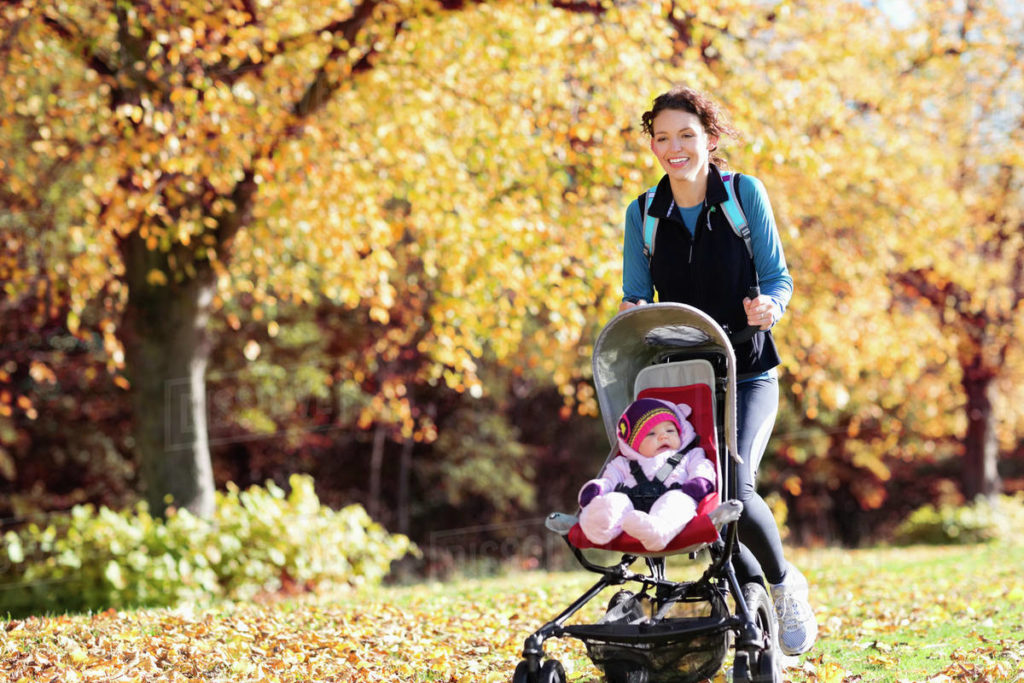Postpartum Athletes’ Return to Fitness and Running Guidelines

By Laurie Gribschaw, DPT, ATC, PRC
Recently, I had the luxury of taking another course on the management of pregnant and postpartum fitness athletes. As a female clinician without children, I try to do everything I can to expand my understanding and clinical skills associated with this underserved population. For too long, women’s health issues have been silenced and unrepresented in the research, but the tides are turning! Normalizing the discussions around incontinence, menstrual cycles, and pelvic girdle pain enable a therapeutic alliance and help women live their best lives during and after childbirth.
Our goal as clinicians working with pregnant and postnatal women is to allow them to stay active throughout their pregnancy while ensuring a safe and healthy return post-pregnancy for any desired activity. A huge component of remaining active during each trimester is appropriate education for you to learn the signs and symptoms that would trigger a regression in activity. While the first trimester may not require any activity modification unless the mother is involved in a high risk pregnancy, second/third trimester activity should be adjusted if the following symptoms arise:
- Getting increased coning or doming of the diastasis recti (a naturally occurring gap in the midline fascia of the abdominals usually starting late 2nd to 3rd trimester)
- Experiencing pelvic pain/heaviness/leaking/bleeding or additional pelvic floor symptoms during exercise
Other guidelines initiated in the 2nd trimester are viewed under the lens of what “should the athlete be doing” vs. what “could the athlete do.” It’s definitely not the time to be pushing and testing the limits of athleticism.
- Reduce any instances of valsalva, or breath holding. This places excessive pressure on the pelvic floor and diastasis recti during a time of already increased burden
- If participating in barbell training, remove any contact of the hip during the Olympic lifts
- Reduce plyometrics around 15-18 weeks and may reduce extension based activities that place excessive strain on a growing abdominal wall (things like pull-ups, overhead press, upward dog)
- Running: decrease volume by 50% as pelvic floor pressures are increasing with fetal growth; ounces of prevention during the late 2nd-3rd trimester allow you to recover faster after delivery and resume training earlier rather than later
As with anything, your experience during pregnancy is unique and very personal, and deserves an ally in your corner to help guide you with appropriate modifications and adjustments to your training. We love helping you on your amazing journey! Especially postpartum when total effort is aimed at keeping this shiny newborn alive, it’s a golden opportunity to use the assistance of a physical therapist to guide your recovery.
You do not have to wait the 6 weeks postpartum to start training again. Yes, I said it; after 1-2 weeks of rest you can start gentle core exercises, especially if you already had a baseline of high activity prior to the birth of your child. Think about it: you are picking up and carrying 6-9 lbs immediately after delivery at high repetitions, there is absolutely no problem adding some staple core exercises back in quite quickly. Obviously there are differences with return from a Cesarean vs vaginal delivery, and the intensity of exercise selection will depend on various grades of perineal tears, but every special circumstance can be a conversation guided by a skilled therapist.
The huge overwhelming standard is: listen to your body!!! If you are struggling with a fussy baby and not getting enough sleep, that is your top priority. Steal those cat naps whenever you can, this is much more important for your mental and physical health than getting back to deadlifting ASAP post baby. Think of your postpartum journey like recovery from an injury; it will be non-linear, it’s unique to your special circumstances, and will depend on a variety of factors.
Dear runners: I love you, but please please put some time in to strengthen with low impact exercises prior to resuming cardio. Your pelvic floor will thank you as the miles stack up. Ideally, running is resumed ~3 months postpartum based on your previous experience and your current symptoms (LISTEN TO YOUR BODY!).
- Using a buggy/jogger: best to use a 2 handed position on the stroller to mimic the speed/stride length of normal running (usually manufacturer’s guidelines suggest waiting until your baby is 6-9 months for their safety)
- Ideally, we would like excellent reduction/management of your diastasis recti (DR) prior to running. Your PT can help educate you to improve and assess your own DR to ensure gradual closure.
- Using a couch to 5K program is a great way to ease back into it; letting your tissues adapt to the new stimulus of jogging.
- You are resilient! Some aches and pains are okay: a 2-3/10 pain scale lasting less than 24 hours is totally fine.
- Increasing signs and symptoms of pelvic floor distress are not okay; do not train through theses! Modify/reduce intensity to stay mostly symptom free. Incontinence is normal for about 3-4 weeks postpartum, but not something you have to live with longer than that time frame.
We are here to help you navigate the complexities of return to activity post baby. No child care, no worries, bring the little one! The 60 minute appointment is all about you, and even educating various positions/postures of early movement with your newborn reaps a wealth of benefits.
